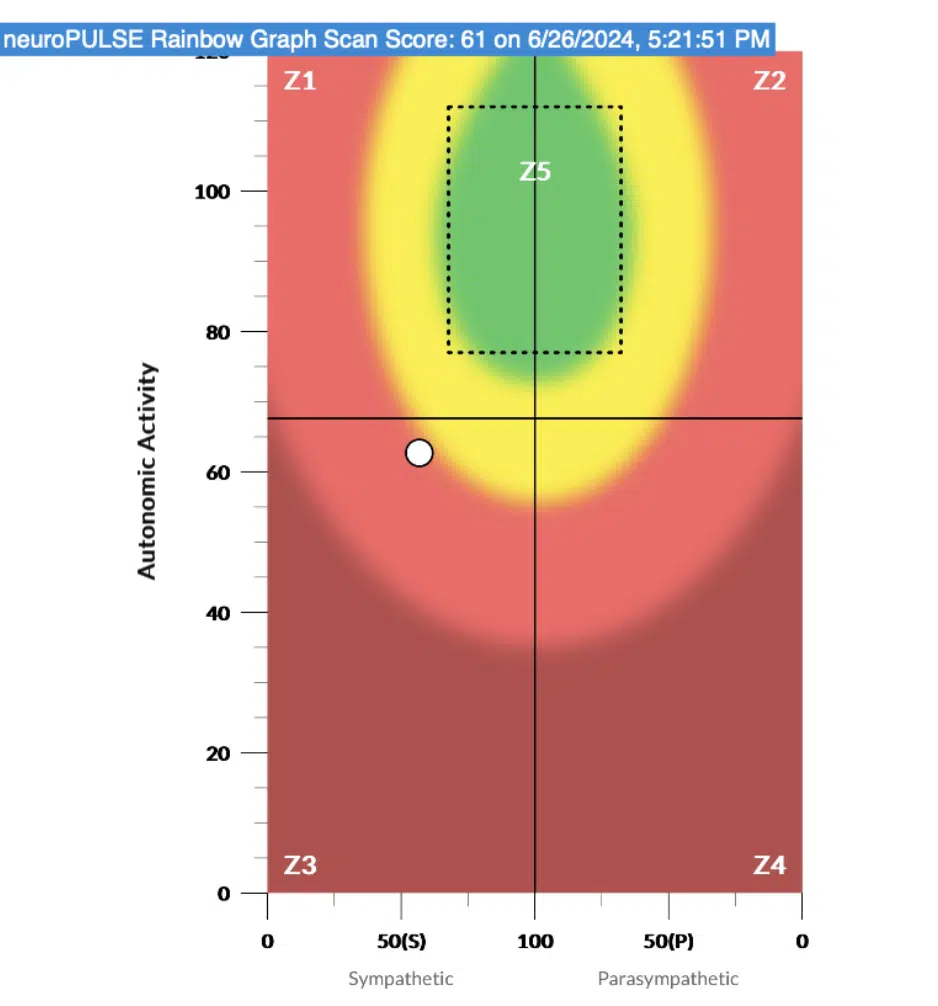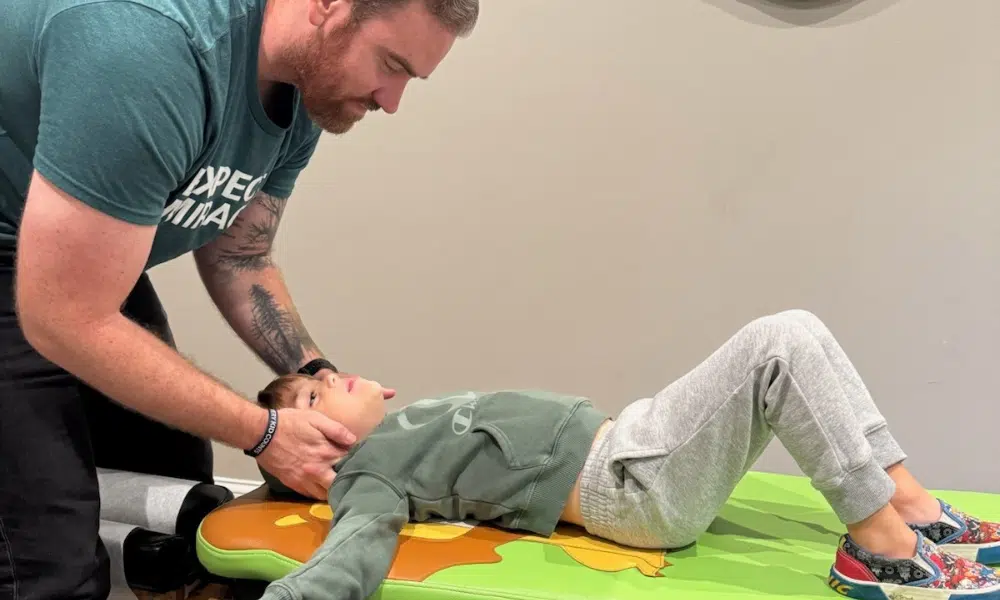Over 80% of children with autism experience sensory processing challenges, with many displaying intense sensory seeking behaviors that both puzzle and exhaust parents. If your child constantly crashes into furniture, seeks deep pressure, spins endlessly, or craves loud noises, you’re witnessing their nervous system’s attempt to self-regulate, not defiant behavior.
Most articles about sensory-seeking autism focus on managing behaviors through sensory diets and occupational therapy. While these help, they miss the crucial question: why is your child’s nervous system driving these intense needs?
At PX Docs, our neurologically-focused approach reveals that sensory seeking often stems from nervous system dysfunction, particularly involving proprioceptive system damage and vagus nerve dysregulation. Through INSiGHT scans, we can evaluate nervous system function patterns behind these behaviors—something traditional assessments can’t do.
You’ll discover the real root causes of sensory seeking, learn how early life factors create these patterns, and understand natural approaches that address the source rather than just managing symptoms.
What Are Sensory Seeking Behaviors in Autism?
Sensory seeking behaviors occur when a child’s nervous system craves specific input to achieve regulation. Unlike typical sensory preferences, these behaviors are driven by neurological need, not simple enjoyment.
Children with autism who display sensory seeking are essentially trying to “feed” their nervous system the input it requires to function. This might look like constantly jumping on furniture, seeking deep pressure through tight hugs, making loud vocalizations, or engaging in repetitive movements like spinning.
Research shows approximately 80-90% of children with autism experience sensory processing differences, with sensory seeking being one of the most common patterns. These behaviors serve a critical regulatory function—helping children organize their nervous system and cope with daily demands.
Here’s what most practitioners miss: Sensory seeking isn’t a behavioral choice or attention-seeking behavior. It’s a neurological adaptation. When you understand this, these intense sensory needs make perfect sense as the body’s intelligent attempt to self-regulate.
At PX Docs, advanced neurological INSiGHT scans reveal that children with pronounced sensory-seeking behaviors show specific nervous system dysregulation patterns, particularly proprioceptive and vestibular systems. This gives families objective proof that there’s a measurable, addressable neurological component driving these behaviors.
Types of Sensory Seeking Behaviors
Sensory seeking behaviors fall into distinct categories based on which sensory systems need input. Understanding these patterns helps parents recognize their child’s specific neurological needs.
Proprioceptive Seeking (Deep Pressure and Heavy Work)
Proprioception involves the body’s awareness of position, movement, and force. Children seeking this input display what parents describe as “heavy work” behaviors that provide deep pressure and joint compression.
Common behaviors include:
- Jumping on beds or trampolines repeatedly
- Crashing into furniture or people
- Carrying heavy objects unnecessarily
- Pushing against walls with full body weight
- Seeking tight hugs or weighted blankets
- Climbing and hanging from playground equipment
The neurological drive behind this often stems from decreased proprioceptive awareness. Children with autism frequently experience proprioceptive processing difficulties, and birth complications have been associated with increased autism risk. When the nervous system doesn’t receive adequate feedback naturally, children seek more intense input.
Vestibular and Movement Seeking
The vestibular system processes movement, balance, and spatial orientation. Children seeking vestibular input appear to be in constant motion because their nervous system craves movement-based feedback for regulation.
Typical behaviors include:
- Spinning in circles repetitively
- Rocking back and forth
- Swinging for extended periods
- Seeking rides that spin or tilt
- Preferring to be upside down
- Rolling down hills or jumping on unstable surfaces
Children with autism often use movement activities like spinning, rocking, or jumping to help regulate their sensory experiences and manage stress.
Tactile and Oral Sensory Seeking
These behaviors focus on touch-based and mouth-related input that serves important regulatory functions.
Tactile seeking includes:
- Constantly touching different textures
- Seeking messy play activities
- Enjoying rough fabrics or intense pressure
- Preferring extreme temperatures
Oral sensory seeking presents as:
- Chewing on non-food items
- Seeking crunchy or chewy foods
- Making vocal sounds for sensory feedback
- Grinding teeth or biting objects
These behaviors often indicate the nervous system requires additional input through the trigeminal nerve system, which upper cervical subluxation can affect.
Why Sensory Seeking Happens: The Neurological Connection
While most discussions describe sensory seeking behaviors, the crucial question remains: what creates these intense neurological needs? The answer lies in understanding how early nervous system development gets disrupted.
At the core of sensory seeking is often dysautonomia—an imbalance in the autonomic nervous system controlling unconscious functions like heart rate, digestion, and sensory processing. When this system becomes dysregulated, particularly between sympathetic (“fight-or-flight”) and parasympathetic (“rest-and-digest”) branches, children develop compensatory sensory seeking patterns.
The proprioceptive system is particularly vulnerable to early nervous system stress. When proprioceptive input decreases due to neurological interference, the brain compensates by driving the child to seek more intense sensory experiences.
The vagus nerve plays a critical role here. This longest cranial nerve connects the brain to major organs and regulates sensory processing, emotional states, and social engagement. When vagus nerve function is compromised—often due to birth trauma or early stress—children develop the intense sensory seeking behaviors parents observe.
The Perfect Storm of Sensory Dysfunction
Sensory seeking behaviors rarely develop in isolation. They typically result from what we call the “Perfect Storm”—a convergence of factors disrupting normal nervous system development during critical periods.
This Perfect Storm often begins before birth. Maternal stress during pregnancy affects fetal nervous system development through stress hormones like cortisol crossing the placental barrier. Research indicates that children born to mothers experiencing significant prenatal stress show higher rates of sensory processing challenges.
Birth trauma and intervention represent another critical factor. Procedures like cesarean sections, forceps or vacuum extraction, and prolonged labor create physical stress to the infant’s delicate brainstem and upper cervical spine—areas crucial for sensory processing. Even minor birth complications can affect neurological pathways responsible for proprioceptive awareness.
Early childhood stressors continue shaping sensory development:
- Frequent antibiotic use disrupting the gut-brain connection
- Chronic ear infections requiring medical intervention
- Disrupted attachment patterns
- Environmental toxin exposure & more
These factors contribute to ongoing nervous system dysregulation, manifesting as sensory seeking behaviors.
How Birth Trauma Affects Sensory Processing
The connection between birth trauma and sensory seeking is significant yet often overlooked. During birth, the infant’s head and neck experience considerable forces, especially during interventional deliveries. The upper cervical spine, housing critical neurological structures, is vulnerable to subluxation—dysfunction interfering with healthy proprioception and nervous system communication.
When subluxation occurs in the upper neck, it directly impacts brainstem areas responsible for sensory integration. The brainstem contains nuclei that process vestibular information, coordinate proprioceptive input, and regulate the reticular activating system, which filters sensory information.
Measuring Sensory Dysfunction: What INSiGHT Scans Reveal
Traditional sensory assessments rely on observational checklists and parent reports—valuable but subjective. At PX Docs, we use INSiGHT scanning technology to objectively measure nervous system patterns underlying sensory seeking behaviors.
INSiGHT scans include three components providing a comprehensive nervous system assessment:
- Thermal Scan: Reveals where the nervous system is stuck in sympathetic overdrive, showing areas of stress and inflammation.
- Heart Rate Variability: Assesses vagus nerve function and overall stress adaptability—low HRV indicates reduced resilience and increased vulnerability.
- Surface EMG: Identifies chronic neuromuscular tension patterns that reflect sustained stress and neurological compensation.
In sensory-seeking children, we consistently observe specific patterns. Thermal scans often show significant asymmetry and color variation, particularly in upper cervical and thoracic regions.

Surface EMG readings typically reveal elevated neuromuscular tension and asymmetric patterns showing the body’s compensation attempts.

Most significantly, heart rate variability scans typically show decreased variability and sympathetic dominance patterns. This objective finding confirms what parents observe—their child’s nervous system is “stuck” in hyperarousal, seeking intense sensory input for regulation.

These findings provide families with concrete evidence that their child’s sensory seeking has a measurable neurological basis. More importantly, they enable targeted care that addresses specific dysfunction patterns, rather than relying on generic approaches.
Beyond Sensory Diets: A Root Cause Approach
Traditional approaches focus on environmental modifications, therapies, and sensory diet strategies. These can be very helpful for families, but without addressing the underlying neurological dysfunction driving the behavior, parents often find their child still trying to overcome the day-to-day struggles.
Sensory diets involve scheduled sensory activities meeting a child’s regulatory needs. They’re valuable for managing daily function but work “outside-in,” providing external input to compensate for internal nervous system dysregulation. This provides short-term relief, but it doesn’t address why the child’s nervous system needs such intense input.
Occupational therapy, particularly when using sensory integration techniques, is a widely used approach for managing sensory-seeking behaviors. These interventions can create meaningful improvements, especially combined with supportive therapies. However, even excellent sensory integration therapy may plateau if underlying neurological stress isn’t addressed.
The neurologically-focused approach recognizes that true sensory regulation must come from within—from a nervous system functioning optimally and naturally processing sensory information appropriately. Rather than constantly providing external compensation, this approach restores the nervous system’s inherent regulatory ability.
This doesn’t mean abandoning helpful modifications or sensory strategies. It means addressing the neurological foundation first, allowing other interventions to work more effectively. Many families report sensory diet activities providing minimal benefit become much more effective once nervous system function improves.
The Neurologically-Focused Solution
Understanding sensory seeking behaviors, which stem from nervous system dysregulation, opens doors to effective, root-cause approaches that support natural healing rather than lifelong management.
Neurologically-Focused Chiropractic Care identifies and corrects subluxation patterns interfering with nervous system communication and regulation. Through gentle, specific adjustments to subluxated areas—particularly the upper cervical region where critical sensory processing centers are located—this approach helps restore the nervous system’s ability to process and integrate sensory information appropriately.
The goal isn’t to eliminate all sensory seeking behaviors, as some sensory exploration is normal. Instead, we focus on helping the nervous system achieve optimal regulation so sensory needs become manageable and less disruptive to daily functioning, learning, and social interaction.
Families often report that as nervous system function improves, sensory seeking behaviors become less intense and more purposeful. Children may still enjoy movement and deep pressure activities, but they’re better able to regulate sensory needs and engage in wider activity ranges without becoming overwhelmed.
Supporting Natural Healing
While neurologically-focused care addresses neurological components, families can support nervous system development through natural approaches, complementing professional care.
Consistent sleep routines become crucial, as quality sleep allows nervous system reorganization and integration of daily sensory experiences. Creating calm, predictable bedtime environments and maintaining regular schedules supports natural healing processes.
Nutrition plays a vital role in nervous system health, particularly foods that support neural development and reduce inflammation. Omega-3 fatty acids, magnesium, and B vitamins are especially important; however, it is recommended to work with healthcare providers to determine appropriate supplementation.
Movement and proprioceptive activities remain valuable, but focus shifts from providing endless sensory input to supporting nervous system organization. Activities like swimming or organized sports provide beneficial input while building body awareness and self-regulation skills.
Moving Forward: Your Next Steps
Understanding sensory-seeking autism through a neurological lens transforms how families approach their child’s needs and creates hope for meaningful improvement. When parents recognize that intense sensory behaviors stem from measurable nervous system dysfunction rather than willful behavior or permanent differences, it opens doors to effective solutions.
The neurologically-focused approach doesn’t dismiss traditional strategies or therapies. Instead, it provides the foundation allowing these approaches to work more effectively. When a child’s nervous system functions optimally, sensory diets become more effective, occupational therapy has a greater impact, and environmental modifications provide better support.
If your child displays intense sensory seeking behaviors, consider evaluation from a neurologically-focused chiropractor who can assess whether underlying nervous system dysfunction contributes to their challenges. Through advanced assessment tools like INSiGHT scans and comprehensive nervous system understanding, these practitioners provide valuable insights into your child’s specific neurological needs.
Every child’s nervous system is unique, and healing timelines vary based on individual factors. However, with consistent support and appropriate care, many children can experience meaningful improvements in sensory regulation and overall quality of life. Visit the PX Docs Directory to find a qualified practitioner near you who specializes in the neurological approach to sensory-seeking autism and can help your child unlock their potential for regulation, development, and joy.






